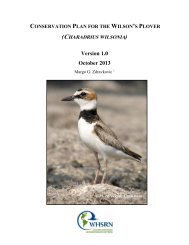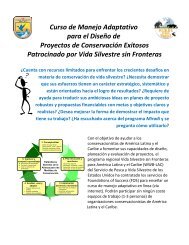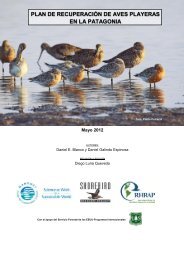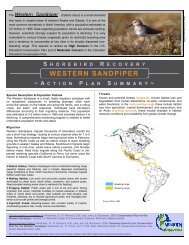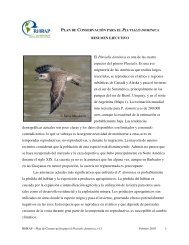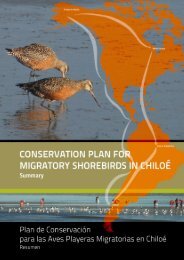Sanderling Plan - Western Hemisphere Shorebird Reserve Network
Sanderling Plan - Western Hemisphere Shorebird Reserve Network
Sanderling Plan - Western Hemisphere Shorebird Reserve Network
Create successful ePaper yourself
Turn your PDF publications into a flip-book with our unique Google optimized e-Paper software.
North America, where data are sufficient to permit more rigorous analyses (Bart et al. 2007).<br />
Within these regions, <strong>Sanderling</strong>s showed a non-significant decline along the Atlantic flyway<br />
(3.2% per year) during the period 1974–1998. In the Midwest flyway, <strong>Sanderling</strong> numbers<br />
showed no significant change (but a non-significant increase of 1.9% per year) over the same<br />
time period (Bart et al. 2007).<br />
Other analyses of various data sets indicate predominantly declining (or less often, stable)<br />
trends in <strong>Sanderling</strong> abundance across migratory flyways and on wintering grounds (Gill et al.<br />
1995; J. Buchanan unpubl. data). The extent (and in some cases, certainty) of population<br />
trajectories has yet to be determined, and design and maintenance of improved monitoring<br />
schemes should be a major priority to enable population status evaluation for this species.<br />
Canadian populations appear to be either declining or stable (Morrison 1993), with<br />
Quebec migrants showing slight declines between 1970 and 1995 (Cyr and Larivée 1995).<br />
Records from fall migration in eastern Canada (the Maritimes <strong>Shorebird</strong> Surveys) indicate a<br />
significant decline in <strong>Sanderling</strong> abundance between 1974 and 1979, an increase between 1980<br />
and 1985, and no significant change between 1986 and 1991. These declines and increases may<br />
reflect an abrupt transition from severe inclement weather on the breeding grounds (during<br />
the1970s), followed by a period of less severe weather (1980s). <strong>Sanderling</strong> abundance also<br />
appears to have declined significantly (1974 to 1998) in the Canadian Maritime Provinces as<br />
well as in Quebec (1976 to 1998), and in Ontario (non-significantly) between 1976 and 1997<br />
(Morrison et al. 1994).<br />
In the United States east of the Rocky Mountains, <strong>Sanderling</strong> abundance has been<br />
declining. International <strong>Shorebird</strong> Survey (ISS) data indicated a significant decline (mean annual<br />
change of -13.7%, cumulative decrease 80.2%) between 1974 and 1983 (Howe et al. 1989; Gill<br />
et al. 1995) along the Atlantic flyway. Spring-migration counts of <strong>Sanderling</strong>s also declined in<br />
Delaware Bay between 1986 and 1992 (Clark et al. 1993). Peak spring and fall counts in<br />
Monomoy, Massachusetts, declined by an order of magnitude (approximately 30,000 to 3,000)<br />
since the 1950s (Veit and Petersen 1993).<br />
During winter, Christmas Bird Counts (CBCs) indicate declining or stable populations<br />
between 1959 and 1988, with significant declines in California (3.7% per year) (Sauer et al.<br />
1996) and especially (-13.7 % annually) along the Atlantic coast from 1974 to 1982 (Appendix<br />
2, Canadian <strong>Shorebird</strong> Conservation <strong>Plan</strong>; Donaldson et al. 2000). On the outer coast of<br />
WHSRN – <strong>Sanderling</strong> Conservation <strong>Plan</strong>, February 2010, v1.1 13





